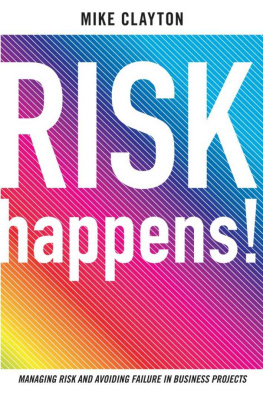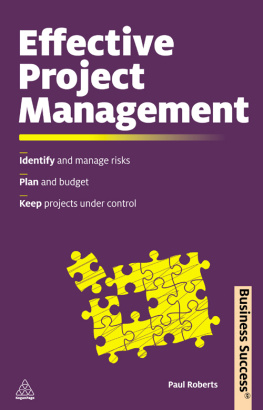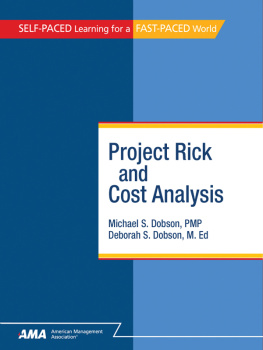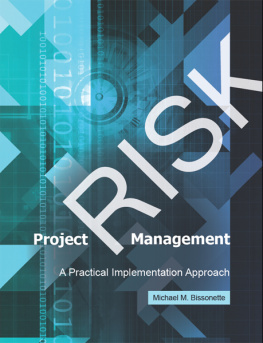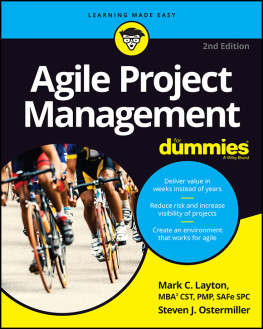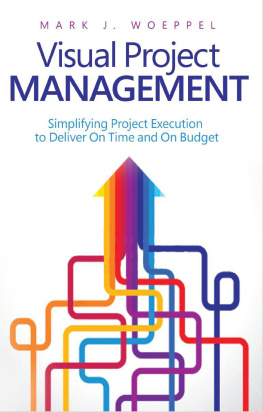MIKE CLAYTON
RISK
Happens!
MANAGING RISK AND AVOIDING FAILURE
IN BUSINESS PROJECTS

Copyright 2011 Mike Clayton
Published by Marshall Cavendish Business
An imprint of Marshall CavendishInternational
PO Box 65829
London EC1P 1NY
United Kingdom
info@marshallcavendish.co.uk
and
1 New Industrial Road
Singapore 536196
genrefsales@sg.marshallcavendish.com
www.marshallcavendish.com/genref
Marshall Cavendish is a trademark of TimesPublishing Limited
Other Marshall Cavendish offices:
Marshall Cavendish International (Asia)Private Limited, 1 New Industrial Road, Singapore 536196 Marshall CavendishCorporation, 99 White Plains Road, Tarrytown NY 105919001, USA MarshallCavendish International (Thailand) Co Ltd, 253 Asoke, 12th Floor, Sukhumvit 21Road, Klongtoey Nua, Wattana, Bangkok 10110, Thailand Marshall Cavendish(Malaysia) Sdn Bhd, Times Subang, Lot 46, Subang Hi-Tech Industrial Park, BatuTiga, 40000 Shah Alam, Selangor Darul Ehsan, Malaysia
The right of Mike Clayton to be identifiedas the author of this work has been asserted by him in accordance with theCopyright, Designs and Patents Act 1988.
All rights reserved
No part of this publication may bereproduced, stored in a retrieval system or transmitted, in any form or by anymeans, electronic, mechanical, photocopying, recording or otherwise, withoutthe prior permission of the copyright owner. Requests for permission should beaddressed to the publisher.
The authors and publisher have used theirbest efforts in preparing this book and disclaim liability arising directly andindirectly from the use and application of this book. All reasonable effortshave been made to obtain necessary copyright permissions. Any omissions orerrors are unintentional and will, if brought to the attention of thepublisher, be corrected in future printings.
A CIP record for this book is availablefrom the British Library
eISBN 9789814351805
Cover design by OpalWorks

For my father, Gerald Clayton,
whose attitude to risk still affects my every decision.
Contents
Tables and Figures
Tables
Table 1.1 Why Crises Happen
Table 2.1 Estimating Techniques
Table 2.2 Common Estimating Errors and Omissions
Table 3.1 Variables of Scale and Complexity for Your Risk Management Process
Table 3.2 Drivers of Scale and Complexity for Your Risk Management Process
Table 3.3 Sample Rolesand Responsibilities for Project Risk Management
Table 3.4 Reasons for Documenting Aspects of Your Risk Management Process
Table 3.5 Typical Contents of a Risk Management Plan
Table 4.1 Core Project Documents
Table 4.2 Typical Considerations for a Project Risk Potential Review
Table 4.3 Indicative Risk Kick-off Workshop Agenda
Table 4.4 Risk Identification Using Personal Experience
Table 4.5 SPECTRES
Table 4.6 Risk Categories
Table 4.7 Risk Register Part 1
Table 4.8 Formal Description of a Risk
Table 5.1 Typical Descriptors for Likelihood
Table 5.2 Typical Probability Ranges for Likelihood
Table 5.3 Suggested Probability Ranges for Likelihood
Table 5.4 Suggested General Scales for Impact
Table 5.5 Suggested Scales for Schedule Impact
Table 5.6 Suggested Scales for Financial Impact
Table 5.7 Suggested Scales for Quality Impact
Table 5.8 Suggested Scales for Scope Impact
Table 5.9 Suggested Scales for Reputational Impact
Table 5.10 Suggested Scales for Health, Safety or Security Impact
Table 5.11 Suggested Scales for Environmental Impact
Table 5.12 Frequently Used Numerical Scale for Likelihoods and Impacts
Table 5.13 Example of an Exponential Numerical Scale for Likelihoods and Impacts
Table 5.14 Failings of Risk Scoring Systems
Table 5.15 Traffic Light Status Definitions
Table 5.16 (a) RMS Method Risk 1
(b) RMS Method Risk 2
(c) RMS Method Calculation
(d) RMS Method Results
Table 5.17 Risk Register Part 2
Table 6.1 Tactics to Remove Project Risk
Table 6.2 Tactics to Reduce the Likelihood of Project Risk
Table 6.3 Tactics to Reduce the Impact of Project Risk
Table 6.4 Contingency Planning Process
Table 6.5 Elements of a Contingency Plan for Project Risk
Table 6.6 Risk Response Plan
Table 6.7 Risk Register Part 3
Table 7.1 Risk Register Part 4
Table 8.1 Leading Indicators of Project Risk
Table 8.2 Crashing the Timeline
Table 9.1 Scenario Planning Process
Table 9.2 Business Continuity Management Process
Table 10.1 The Stages of Resistance to Change
Table 10.2 Examples of Project Stakeholders
Table 10.3 Factors Affecting Stakeholders Attitudes to Risk
Table 10.4 Project Communication Strategy
Table 10.5 Stakeholder Communication Plan
Table 11.1 Typical Factors leading to a High Risk Project
Table 13.1 Typical Benefits of a Strong Risk Management Culture
Table 13.2 Elements of a Strong Organisational Risk Culture
Table 13.3 Steps in Creating a Strong Organisational Risk Culture
Table 13.4 Risk Management Maturity Levels
Table 13.5 Lessons Learned Register
Table 13.6 Post-Project Risk Review
Figures
Figure 1.1 Risk Mirror
Figure 1.2 Project Risk Management
Figure 2.1 Project Cost-Risk Profile
Figure 2.2 Time-Cost-Quality Triangle
Figure 2.3 Time-Cost-Quality-Scope
Figure 2.4 Scope
Figure 2.5 Risk Breakdown Structure
Figure 2.6 Scope Creep and Defining Scope
Figure 2.7 Work Breakdown Structure
Figure 2.8 Product Breakdown Structure
Figure 2.9 RACI Chart
Figure 2.10 PERT Estimates
Figure 2.11 Slippage in Highly Dependent Tasks
Figure 2.12 Islands of Stability in a Project Schedule
Figure 2.13 Cost and Organisational Breakdown Structure
Figure 3.1 The Risk Management Process/span>
Figure 3.2 Core Risk Management Documents
Figure 4.1 Periodic Review to Identify New Risks
Figure 4.2 Starting Place for Identifying Project Risks
Figure 4.3 SWOT Analysis
Figure 4.4 Fishbone Diagram
Figure 4.5 Fishbone Diagram Stage 2
Figure 4.6 Process Decision Programme Chart
Figure 4.7 The Formal Structure of a Risk
Figure 5.1 Likelihood versus Impact Chart
Figure 5.2 Likelihood versus Impact Chart, with Scoring
Figure 5.3 Risk Dependency Map
Figure 5.4 Likelihood versus Impact Chart, with Colour Zones
Figure 5.5 Time to Impact versus Likelihood, with Bubble Size Representing Impact
Figure 5.6 Time to Impact versus Complexity, with Bubble Size Representing Impact
Figure 5.7 Likelihoods of 2 Independent Events, with Bubble Size Representing Impact of Combined Outcome
Figure 5.8 Likelihoods of 2 Independent Events, with Bubble Size Representing Impact of Combined Outcome
Figure 5.9 Decision Tree Example
Figure 5.10 The Beta Function
Figure 5.11 Examples of Statistical Distributions
Figure 5.12 The "Sleep at Night Test" Results
Figure 6.1 When to Do Risk Planning
Figure 6.2 Contingency Planning Process
Figure 6.3 More Research in Your Risk Management Process
Figure 7.1 Take Action on Risks
Figure 7.2 Consequential Risks Arise from Treating an Existing Risk
Figure 8.1 Risk Monitoring and Control
Figure 8.2 Earned Value Analysis
Next page
